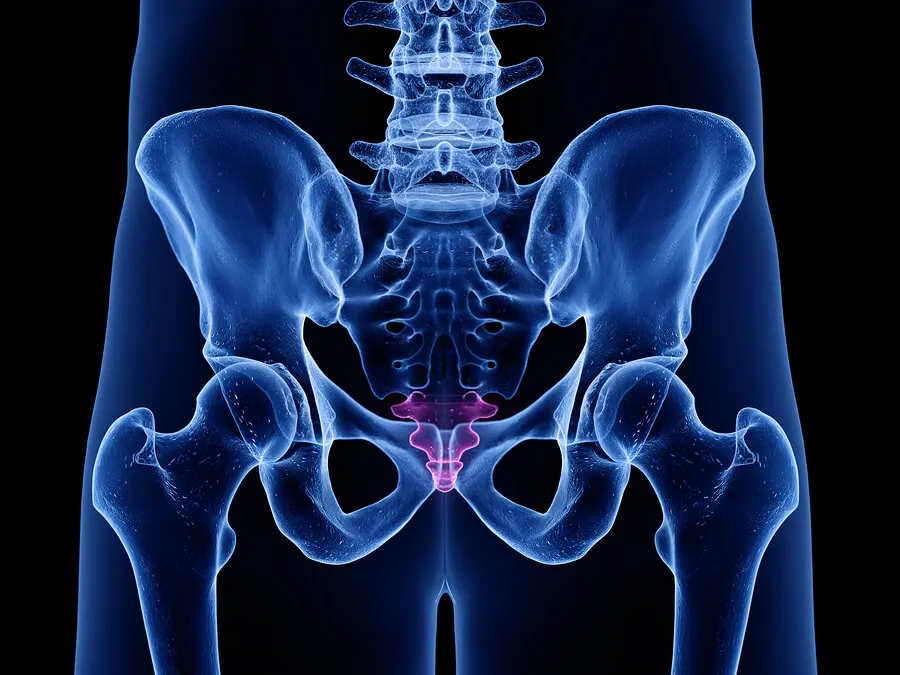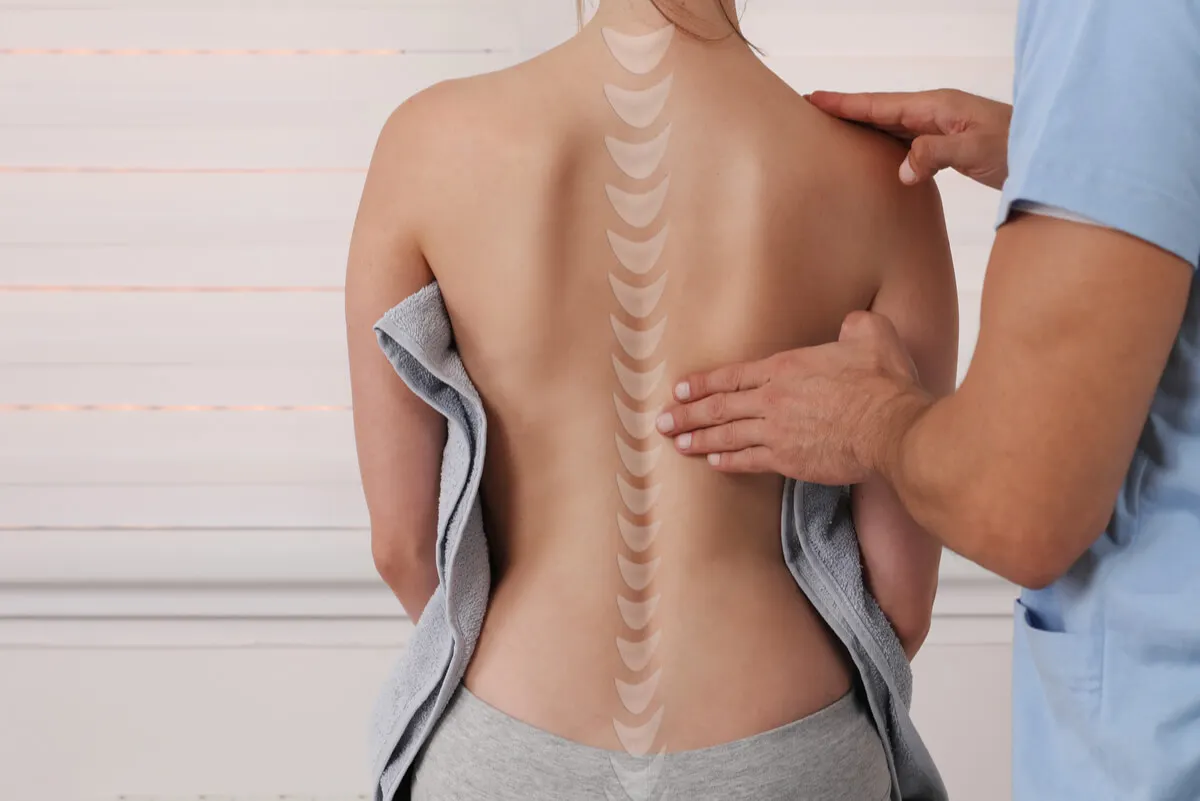Coccyx Pain: 9 Possible Causes and How to Relieve It


Reviewed and approved by the doctor Leonardo Biolatto
Coccyx pain, also called coccygodynia, is pain that occurs at the end of the spine, just where the buttocks begin. The intensity varies, although sometimes the discomfort increases when sitting or when adopting certain positions.
The causes are varied, including injuries and bad postures. It may require treatment with painkillers, but other times, it goes away on its own or by applying some home measures.
The prevalence of coccyx pain
The coccyx or coccyx is a bone composed of three or five fused vertebrae. It’s located at the end of the spine, at the base, and just below the sacrum.
It’s the weight-bearing bone when sitting, along with the lower part of the pelvis. In adults, it tends to curve a little. When this occurs in excess, it can cause some problems.
Among such problems is coccyx pain, which is also known by other names such as sacral bone pain, coccygeal pain, coccydynia, coccygodynia, or cocciaglia. According to research, it accounts for about 1% of consultations for spinal complaints.
It’s more common in women. It’s thought that this difference may be due to the location of the female coccyx, which is more posterior or exposed.
We think you may be interested in reading this, too: Arnica and Coconut Oil Ointment to Treat Lower Back Pain
Associated symptoms
The pain in the coccyx usually presents as a constant stabbing sensation in the bone. Other times, it’s felt when the area is touched or felt. It may radiate to the waist.
It’s usually worse with prolonged sitting or standing, an activity that puts more pressure on the bone, and sudden movement. Occasionally, there may be pain during defecation or sexual intercourse. In women, it also causes discomfort during menstruation.
Other symptoms that may accompany it are the following:
- The appearance of bruising
- The sensation of pressure or numbness in the buttocks
- Reduced quality of rest

Possible causes of pain in the coccyx
There are several causes that can lead to the appearance of pain in the sacral or coccygeal area. Among them are the following:
1. Injury or repeated trauma
As a result of falling while sitting or receiving a blow to the waist area, we may suffer an injury or trauma that can cause pain in the coccyx. It should be clarified that fractures of this bone are not as frequent, but they still occur.
A longer recovery time may be required.
2. Repetitive action
Pain may be due to performing an action that generates constant pressure on the bone, such as riding a horse or bicycle. Even when running or going down and up stairs.
3. Bad movement or overexertion
Another situation related to the appearance of coccyx pain is bad movement when bending down or overexertion when lifting something heavy.
4. Bad posture
Maintaining a bad body posture while sitting for a long time, while working in front of the computer, or while driving, is also a factor associated with the occurrence of coccyx pain.
5. Pregnancy and childbirth
In the last months of pregnancy, the bones of the lumbar area settle differently. They become more flexible or mobile. Also, during delivery, the baby’s head may injure some structures.
6. Overweight or obesity
Maintaining a weight above that which is appropriate for the size or a high body mass index (BMI), around 30, also increases the pressure on the coccyx.
7. Herniated disc
In some cases, coccyx pain may be the result of compensation, in the sense that the person changes the way he or she sits or stands to avoid discomfort. This happens, for example, when there’s a herniated disc in the lumbar region.
8. Degenerative joint processes
Processes such as degenerative joint disease (DJD) affect the cartilage that lines the joints and bony structures. If this occurs in the lumbosacral region, for example, there may be pain in the coccyx.
9. Other causes
Less commonly, coccyx pain may be due to a tumor, a cyst, or pilonidal disease, which is an infection caused by a buildup of hairs and dead cells under the skin.
Like this article? You may also like to read: Relieve Back Pain with a Simple Breathing Technique
Treatments for coccyx pain
Coccyx pain may subside on its own within a few days. However, some become chronic and persist for weeks.
In these cases, the recommendation is to see a doctor.
The health professional will examine the area for signs of fractures, the presence of lumps, or signs of infection. He/she will also question the patient as to whether he/she has suffered any blows or what his/her habits are.
As a complementary measure, he/she may request diagnostic imaging tests. These may include X-rays, CT scans, or MRI scans.
Treatment will vary depending on the cause and severity of the symptoms. Several of the following options may be combined:
- Nonsteroidal anti-inflammatory drugs, such as ibuprofen, naproxen, and others, reduce pain and inflammation.
- Injections of anesthetics and steroids may be recommended when the pain is very powerful.
- Physiotherapy: this includes massages, chiropractic treatment, and transcutaneous electrical nerve stimulation, among others.
Surgery is sometimes performed to partially or totally remove the coccyx bone. However, this is recommended only when other options haven’t worked. And although this is an operation that can be done easily, recovery can take several months.

Other measures to reduce or prevent coccyx pain
In addition to the treatments mentioned above, a number of recommendations can be taken into account to attenuate coccyx pain or even prevent it. However, home remedies should be applied only when authorized by a doctor and once the causes have been determined.
In this regard, the following options are available:
- Rest: strong physical activities that have an impact on the spine should be suspended.
- Apply local ice to your lower back. Also, alternately, use heat with compresses.
- When sitting, your body should be leaned forward a little, so that the weight falls on your legs. For greater comfort, special sitting cushions should be used. When pain is present, the best sleeping position is on one side.
- Constipation should be combated by drinking enough fluids and consuming fiber.
- People who are overweight should try to lose weight.
- There are some appropriate exercises, such as those done when there’s a herniated disc or low back pain, to stretch and strengthen the muscles of the lower back.
Should a doctor be consulted for coccyx pain?
In certain cases, as already mentioned, coccyx pain decreases or disappears when we modify the activity or habits that caused it to appear. However, we should not be overconfident.
In this sense, it’s a good idea to go to the doctor when the discomfort persists or when it’s very intense. Also, you should see a doctor if other symptoms are present, such as inflammation, redness, and the sensation of heat in the skin of the area.
All cited sources were thoroughly reviewed by our team to ensure their quality, reliability, currency, and validity. The bibliography of this article was considered reliable and of academic or scientific accuracy.
- Bannura G. Enfermedad pilonidal sacro-coccígea: factores de riesgo y tratamiento quirúrgico. Rev Chil Cir. 2011; 63(5): 527-533.
- Emerson S, Speece A. Manipulation of the coccyx with anesthesia for the management of coccydynia. J Am Osteopath Assoc. 2012; 112: 805-807.
- Navarro Navarro R, Navarro García R, Santana Suárez R, Barroso Rosa S. Coccigodinia. Situación actual, diagnóstico y tratamiento. Canarias médica y quirúrgica. 2011; 2: 28-37
- Ortega Sánchez-Pinilla R. ¿Cuáles son los ejercicios indicados en la lumbalgia crónica y en la hernia discal? FMC – Formación Médica Continuada en Atención Primaria. 2020; 27(1): 34-46.
- Patel R, Appannagari A, Whang P. Coccydynia. Curr Rev Musculoskelet Med. 2008; 1(3-4): 223-226.
- Rivero Torres R, Álvarez Fiallo R. Hernia discal lumbar: algunos aspectos del diagnóstico. Rev Cub Med Mil. 2004; 33(2). Disponible en: http://scielo.sld.cu/scielo.php?script=sci_arttext&pid=S0138-65572004000200003&lng=es.
- Salar O, Mustaq F, Ahmed M. Defecation pain and coccydynia due to an anteverted coccyx: a case report. J Med Case Rep. 2012; 6: 175. Accessed 7/1/2020.
This text is provided for informational purposes only and does not replace consultation with a professional. If in doubt, consult your specialist.








